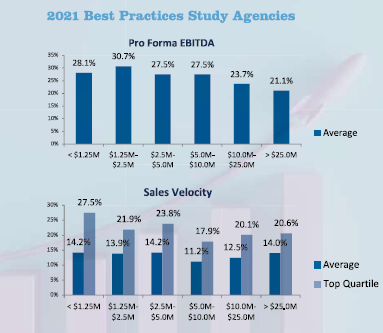If you're buying an agency, these characteristics are important to understand to ensure you don't overpay. If you're a seller, knowing these characteristics before going to market allows you to maximize your deal.
In our mergers & acquisitions consulting business, we are often asked what an agency might sell for in the open market. Generally, we provide a range. Not surprisingly, most agency owners assume they'll be at the high end of any range, but a few owners will ask the right follow-up question: What would my agency have to look like to qualify for a valuation at the high end of the range?
There are a handful of characteristics that usually dictate an agency's ultimate value. If you're buying an agency, these characteristics are important to understand to ensure you don't overpay. If you're a seller, knowing these characteristics before going to market allows you to maximize your deal.
Here are three metrics from the Best Practices Study, a joint initiative between Reagan Consulting and the Big “I," that put an agency on the high-end of the spectrum:
1) Organic growth. Expressed as a percentage, organic growth reflects total year-over-year growth adjusted to eliminate any acquisition or divestiture activity and to eliminate contingent, investment, and miscellaneous income. It is the most fundamental metric used when considering an agency's growth culture.
As helpful as organic growth is in considering an agency's growth culture, it does have its limitations. Organic growth is impacted by rate, retention, exposure changes and new business. Exposure changes and rate changes are market-driven and outside an agency's control. Retention, which is impacted by both internal and external factors, is another major variable in measuring growth.
While there may be limits to an agency's ability to manage retention, the most important controllable contributor to an agency's organic growth tends to be new business. As the old saying goes, “nothing good happens until someone sells something." And so it goes for an insurance agency—new business is king. Without an effective new business engine, an agency can become a static enterprise with a mediocre valuation. To better understand the role of new business in organic growth, we developed a complementary best practices metric known as sales velocity.
2) Sales velocity. Calculated as current period written new business divided by prior period recorded commissions and fees, sales velocity is the metric that answers the question: To what extent are our sales efforts contributing to our organic growth?
An agency with an organic growth rate of 5% in an environment providing a 5% rate lift is likely not doing very well when it comes to new business. Sales velocity can help to highlight that reality.
 3) Profitability. When referring to pro forma profitability, we often focus on EBITDA, or earnings before interest, taxes, depreciation, and amortization. To get to actual profitability, we make adjustments to EBITDA to arrive at pro forma profitability. Think of pro forma EBITDA as EBITDA after eliminating non-recurring activity, along with excess compensation and perks paid to owners.
3) Profitability. When referring to pro forma profitability, we often focus on EBITDA, or earnings before interest, taxes, depreciation, and amortization. To get to actual profitability, we make adjustments to EBITDA to arrive at pro forma profitability. Think of pro forma EBITDA as EBITDA after eliminating non-recurring activity, along with excess compensation and perks paid to owners.
Pro forma EBITDA is the most common profitability metric used in the Best Practices world. Note that pro forma EBITDA margins tend to decrease as agencies get larger and larger. The reason for this is that larger agencies tend to invest much more heavily in growth initiatives and value-added resources. When reviewing Best Practices profit margins, focus on your peer group's results, not those for agencies of different sizes.
If you're particularly motivated, focus on achieving top-quartile Best Practices agencies' growth and profitability results. By doing so, you will ensure that your agency's value will qualify for the highest possible valuation. You have worked too long and too hard to settle for anything less.
Tom Doran is a partner at Reagan Consulting.
Want to participate in the Best Practices Study? Nominations are now open for the 2022 Best Practices Study. Find out more.
